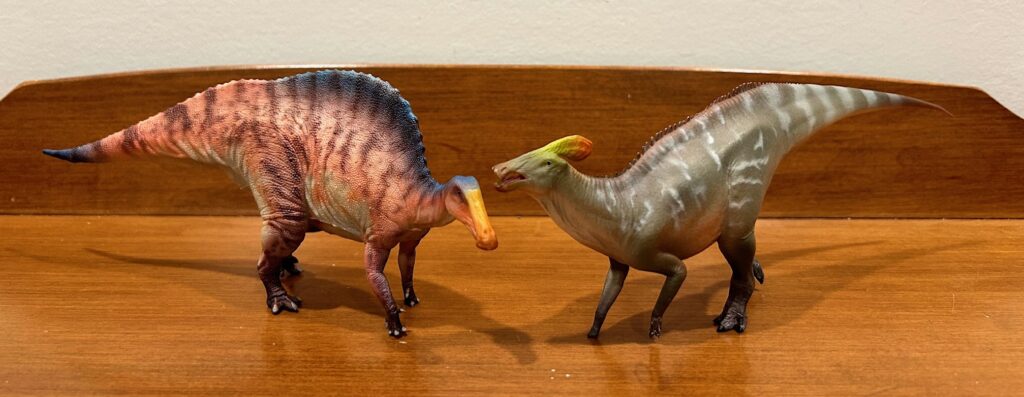For a decade now, I’ve been reviewing toys of prehistoric fauna from across the entire globe, including Canada, the United States, Patagonia, Brazil, Argentina, Chile, the United Kingdom, Portugal, Spain, France, Belgium, Germany, Greece, Romania, Russia, Morocco, Niger, Egypt, Tanzania, Madagascar, India, Mongolia, China, Japan, Australia, and Antarctica. Now here’s the very first one from the magnificent nation of Mexico: the crested lambeosaurine hadrosaur Tlatolophus!


Tlatolophus lived between 73 and 72 million years ago and is known from most of the skull, including the crest, a shoulder blade, a femur, parts of the pelvis, and most of the tail. It was a good-sized herbivore, measuring around 8 metres in length. Haolonggood’s Tlatolophus is sculpted soodling along with its head raised and turning slightly to the right, its tail raised even higher, its left hand raised a little bit off the ground, and its right foot extended back in mid-step. This gives it a length of 22.5 cm long and a height of 8.5 cm. The mouth is open as though the animal is sounding off or browsing on vegetation.


This is the “An Dao Quan” Tlatolophus. Its main colour is a pale shade of dark green that gives way to fleshy pink for the underside. The hands and feet are a dark grey-brown with black claws. Whitish-blue stripes decorate the body and the tail, which is tipped off with reddish-brown. The latter colour also runs down the toy’s neck and back. The head features a medium brown bill, a bright pink mouth, beady black eyes, and lastly, a crest of light green, yellow, and flaming red-orange. I selected this one over the “Huang Fu Duan” version because to me, the colour scheme has a warmer, livelier, more Mexican vibe to it. Especially that bold crest. My only beef is that the left hand has flecks of white all over it. A tiresome factory error, it seems.

Tlatolophus means “word crest” and it refers to the fact that the crest jutting from its cranium bears a resemblance to the Aztec glyph for speech. Haolonggood has done an excellent job of rendering said crest on this toy. It has the correct shape and along with the bright colouration, makes its owner stand out among other lambeosaurine toys. Tlatolophus also boasted a tail that was particularly long among hadrosaurids, and this is too reflected here. The tail starts out very wide and deep, but eventually dwindles down to a very spindly tip.

At first glance and touch, the skin on this toy may seem relatively smooth, but closer inspection shows that there is in fact a very faint and miniscule scale pattern all over. There’s also lots of wrinkles around the joints and on the feet and the head. The crest is rather wrinkly to boot. A single row of rather rectangular osteoderms starts partway down the neck and runs to about a quarter of the tail. Unlike the osteoderms on many other dinosaur toys, these ones vary wildly in height as they go, alternating waves of short and tall.

In addition to the correctly shaped crest and the long tail, this Tlatolophus boasts a very thick, muscular neck, as opposed to the rather skinny necks that hadrosaurs used to be given in paleoart. The torso, the hind legs, and the arms also appear to be properly proportioned, and the latter terminate in small, mitten-like paws.


Overall then, the Haolonggood Tlatolophus is a very good and very unique toy, and certainly well worth the purchase. Hopefully we’ll see more Mexican dinosaur toys come about in the future, such as the theropod Labocania, the ceratopsian Coahuilaceratops, and of course, the lambeosaurine hadrosaurs Magnapaulia and Velafrons.

Disclaimer: links to Ebay and Amazon on the DinoToyBlog are affiliate links, so we make a small commission if you use them. Thanks for supporting us!




Such a graceful figurine! Really captures the balance of size and elegance in these animals. I have the brown variant, but you can’t go wrong with either!
Another 5-star “home run” from Haolonggood. I have this one displayed with my 1:40 figures as its not all that large. a+++
Good review of a good model. I couldn’t resist buying both versions – as often seems to happen for me with Haolonggood models!
Great review of a great figure. 5 stars! (BTW, in the fifth paragraph, you misspelled wrinkly. Just thought you ought to know)